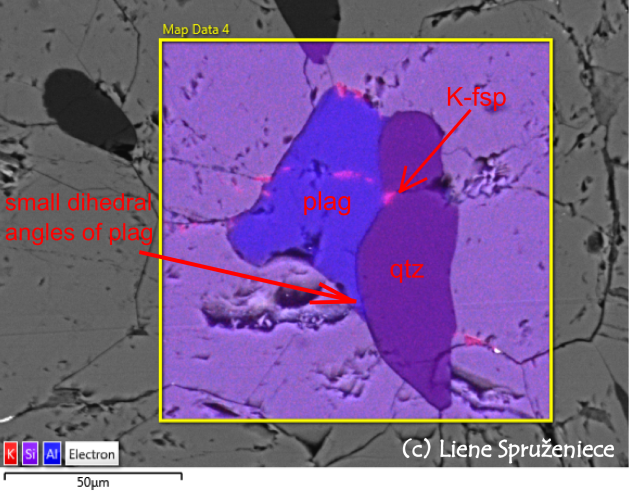An unfortunate discovery
January 24, 2013 5 Comments
The last 2 weeks were huge ups and downs in my academic life. I made my very first scientific discovery and I lost my main field area.
Recently I spent much time studying the thin sections from New Zealand, from the place where I have an upcoming fieldwork soon. I was especially looking on samples from shear zones (the sites of intense deformation in the Earth’s crust). I looked on the thin sections under a polarized light microscope and tried to understand how the rocks behave when they get deformed and how the presence of water affects their behavior during the deformation. After a while I started to notice some odd things there:
- Firstly, the minerals in these shear zones got more mixed with increasing deformation. Normally in a highly strained rock I would expect the formation of metamorphic banding defined by layers of softer and harder minerals, as the pockets of soft minerals tend to interconnect during deformation and provide surfaces where most of the slip happens in the rock.
- Secondly, the grain sizes in the center of shear zone where larger comparing to the less deformed rock on the margin of the shear zone. Normally deformation reduces the grain sizes in a rock.
- Thirdly, the grains in the centre of the shear zone showed less deformation structures than at margins of the shear zone.
And then, all these new amphibole grains with their strange crystal faces! The shapes, the occurrence, the size seemed just wrong, wrong, wrong! So I took my samples and went to my supervisor for some enlightenment on the matter.
She told me to do a bit of electron microscopy to get a closer look on the microstructures and check the chemistry in the most suspicious samples. A day in a lab (in a very cold lab) and I got results suggesting that my shear zones contain bits of melt. It was an extremely exciting discovery because nobody of the previous workers has recognized a melt in these shear zones before. At this moment I felt super-cool about myself for picking this up. However my joy did not last long. Very soon my supervisors reminded that I am not supposed to study the role of melt in shear zones. I am supposed to study the role of water in shear zones. And easy as that, my field area got discarded. The melt in the shear zones means that the original structures are modified. It means that much evidence is probably erased. Eventually it makes the system so complicated that it is impossible to recognize the fundamental principles of the processes which I am interested in. A huge bummer for me.
After all I got a permission to tag along for the fieldwork in New Zealand anyway but it won’t be a fieldwork for my project. And the melt discovery most likely will get handed over to somebody else to work with. As Heidi Klum once famously used to repeat: “One day you’re in. And the next day you’re out” (c)ProjectRunway.
Oh, well, I still have 3 years of my PhD to go. And this is just a beginning.
Some melt microstructures:

Electron backscatter image showing melt microstructures (qtz – quartz, bt – biotite, amph – amphibole, plag – plagioclase). Electron microscopes does not use light therefore images are in a grayscale. In these kind of images the heaviest minerals appears to be brighter while the lightest minerals have a darker colour.

A typical mineral assemblage crystallizing from a leucosome (plag + qtz + K-fsp). Small angle of the plagioclase crystal against quartz suggest the crystallization from melt. The electron image is colour-coded by the abundance of K, Si or Al.


This is all a bit (over)-dramatic! How can you be so sure these are melt microstructures and not an Si-rich fluid replacing biotite. I would probably interpret the way the quartz surrounds the biotite differently. You should do some EBSD on the fragments of biotite which seem to be “floating” in your melt. (What would this tell you?)
Also I can see why this makes any difference to your project. If a melt IS generated in a shear zone, or if the strain localisation is due to a melt, then this is also important to the interpretation of shear zones.
In the case of biotite, quartz which surrounds it is a single grain. Maybe that can occur by a reaction as well but it is exactly what we expect if it would be a melt crystallizing as quartz around the solid biotite grains.
However, the most convincing argument for melting is the frequent occurrence of plagioclase, quartz and K-feldspar in small pockets surrounded by amphibole. This is a typical assemblage to crystallize from a leucosome and the small dihedral angles of plagioclase in this assemblage are difficult to explain by a metamorphic reaction.
Also the deformation conditions were estimated as T~670 degrees C and P~14 kbar (Daczko et al., 2001). It is enough to initiate melting at the influx of fluid.
I mean I cannot see why this makes such a difference to your project…
We were talking about this with my supervisors. The melt can indeed be considered as a fluid so it is possible to integrate this in my project. The problem is that my project is already very extensive, especially the experimental part. As the experiments will be done with hydrous fluids, it is also better if the structures in the natural shear zones I work on are caused by hydrous fluids and so can provide a reference to compare with experimental results.
Even if I am very interested to learn about the partial melting, it can cost too much time away from the things I am supposed to do.
Pingback: Every cloud has a silver lining « Mente et malleo: by thought and hammer